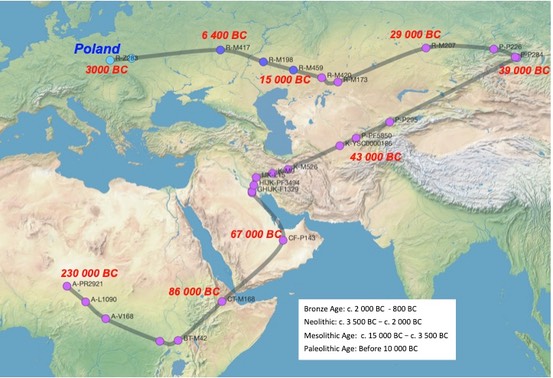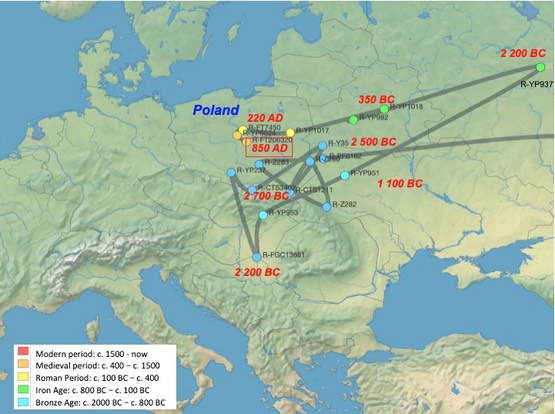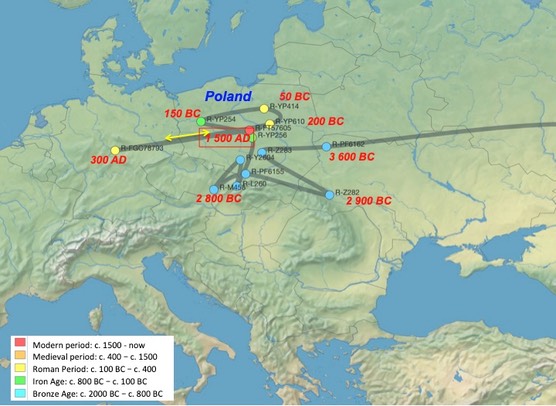__________________________________________________________________________________________________________
Ancestor Migration
Getting to know your family history or the origin of a family name is a hobby for many. As amateur genealogists we often research family heirlooms, search archives, and submit to DNA testing. Our goal here is to document the history of families with the surname Radzimski or Radziemski and to enable contact with people interested in this topic. Our work to date has taught us the following:
- The history of the name Radzimski / Radziemski dates back to the years 1350-1400. According to historical documents, Maciej of the Borek family took the surname Radzimski from the village of Radzim when he was bequeathed this village.
- There are at least nine towns in Poland called Radzim and it is expected that some owners of these towns may have taken the surname. Therefore the Radzimski/Radziemski surname appeared in more than one place in Poland.
- Civil documents indicate that Radzimski and Radziemski were in many cases interchangeable. When people registered births, marriages, or deaths with the church they could not verify what was written in the records because they were illiterate.
- So far, DNA analysis shows us that there are two separate genealogical branches of Radzimski/Radziemski families. As we reported recently on our web site, one of the branches is YP237, called the South Baltic branch, and the other is R-L260, called the West Slavic branch. These branches, called also haplogroups, belong to the R1a group, which dominates the European continent among Slavs and Hungarians. This information came from testing done by us in Spring of 2020.
Below we present the results of a more complex and more accurate genetic test called the Big Y-700 provided by FamilyTreeDNA.com. This test analyzes thousands of DNA markers of a person in which the Y-chromosomes are examined. The test results allowed for more accurate identification of the branches where the Radzimski / Radziemski families originate. This allows a determination how the family tree of each group changed historically over 260,000 years, i.e. since our ancestors left Africa.

Fig. 1. Early migration route of the West Slavic and South Baltic groups to the last common branch. Dates of selected branches marked in red (map generated using web site: scaledinnovation.com).
The map in Fig. 1 shows the first part of the ancestor’s journey that is common for both groups mentioned above. Until about five thousand years ago there was no distinction between the South Baltic and West Slavic branches. The last branch was R-Z283 formed about 4900 years ago and it was located in the area of current South-Eastern Poland. From this point and time, the R-Z283 branch split. One part of the Radzimskis headed first to the south of Europe and later, about 2000 years ago, returned to present-day Poland. This group as mentioned before is called West Slavic and its migration is shown in Fig. 2. The second group went back toward Asia and returned back couple thousands years later and settled in the territory occupied today by Poland. Some members of this group move further to Western Europe (current Northern Germany) and some to North (current Sweden). That is why this group is called South Baltic.

Fig. 2. European part of migration route of the West Slavic group R-FT57605. Dates of selected haplogroups marked in red (map generated using web site: scaledinnovation.com).

Fig. 3. European part of migration route of the South Baltic group R-FT206320. Dates of selected haplogroups marked in red (map generated using web site: scaledinnovation.com).
For the West Slavic group, the Big Y test identified a new F-FT57605 group. This group was formed about 500 years ago. For the South Baltic group the test identified new group called R-FT206320 and this one was formed about 1150 years ago. This information has to be taken with a grain of salt. The number of people who have taken the most accurate test at the moment is very small and therefore the accuracy of the test is reduced. The fact that we are dealing with at least two groups of Radzimski / Radziemski ancestors is certain. The presence of people with separate ties to the northern and southern parts of Europe assures us of their independent history.
For a more detailed analysis of the dates and places related to the migration of the Radzimski and Radziemski ancestors, we must wait for more people to participate in this genetic testing.
Additional valuable information that this genetic test provides is the search for specific family connections. The Big Y-700 test identifies all people who are genetically related up to the 8th generation with an accuracy of 95%. Of course, it only finds people who took a similar test. We encourage all people with genetic ties to the Radzimski / Radziemski families to participate in genetic tests so that we can enrich the history of these families.
ZR & LJR
